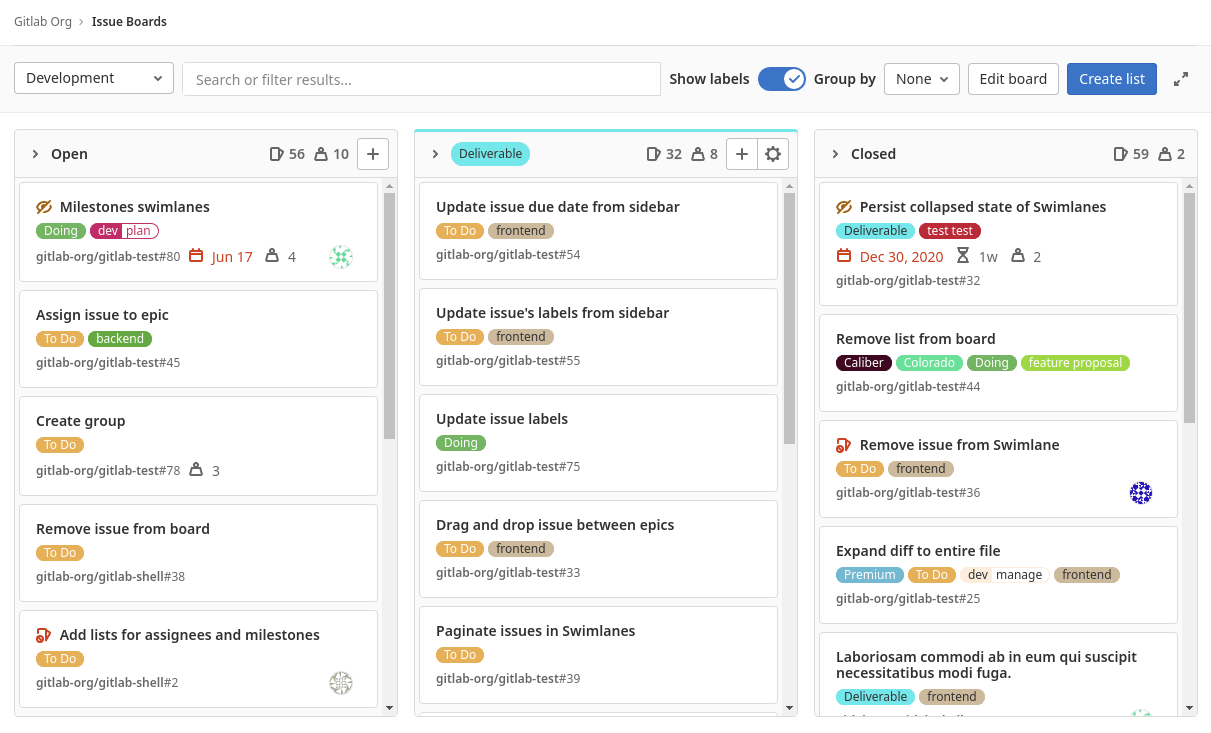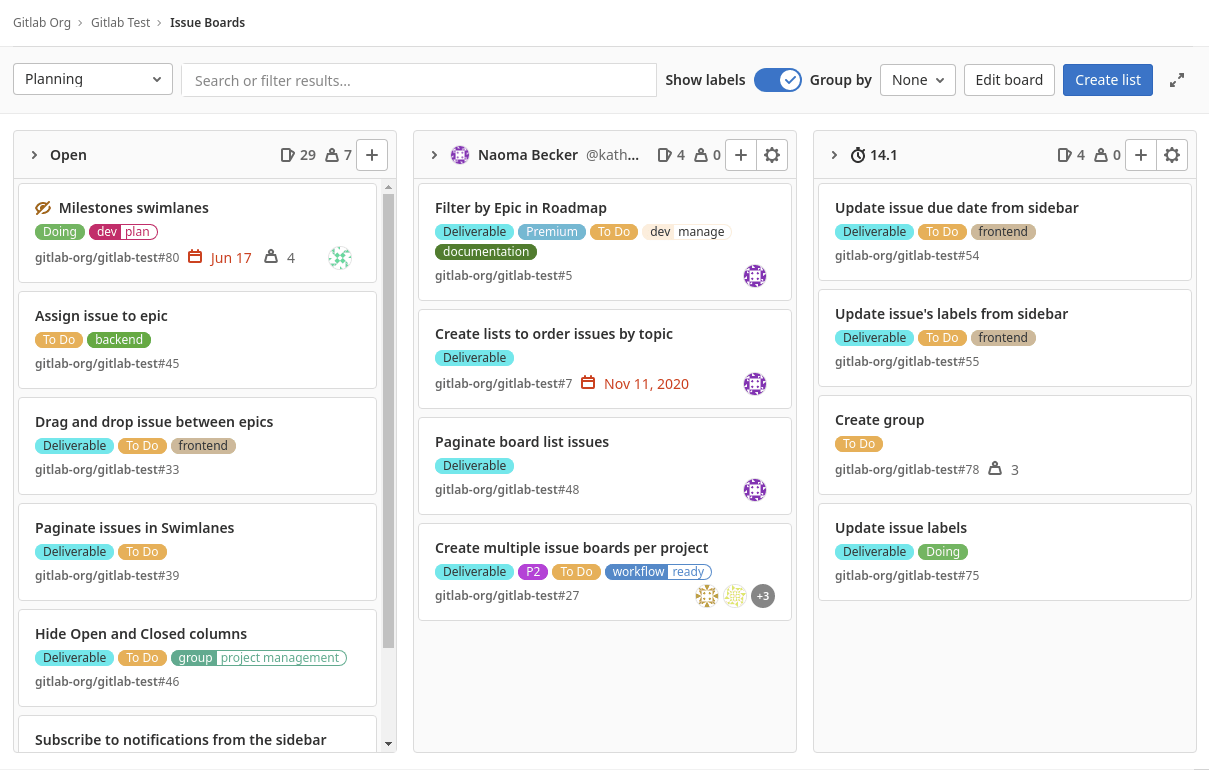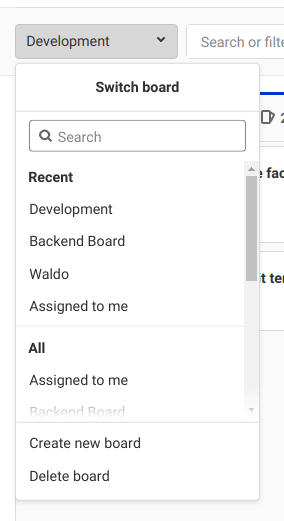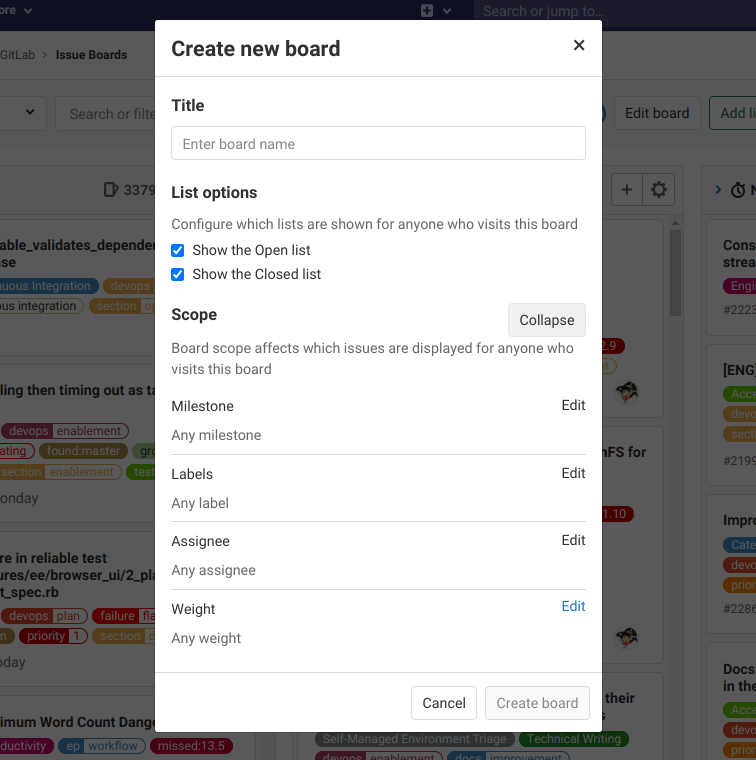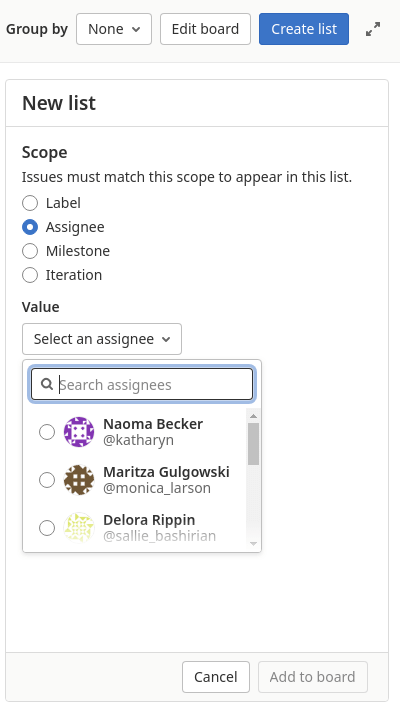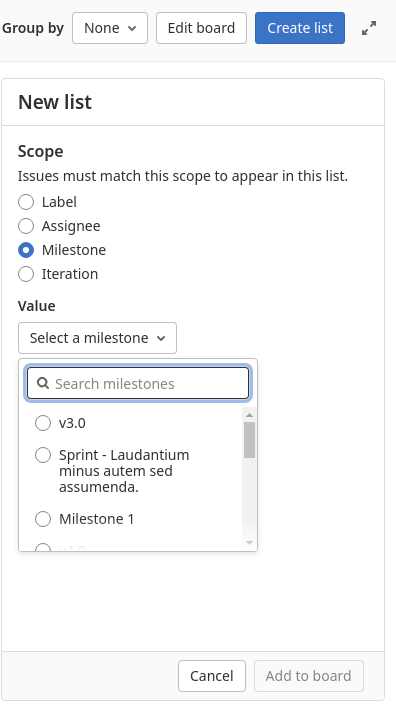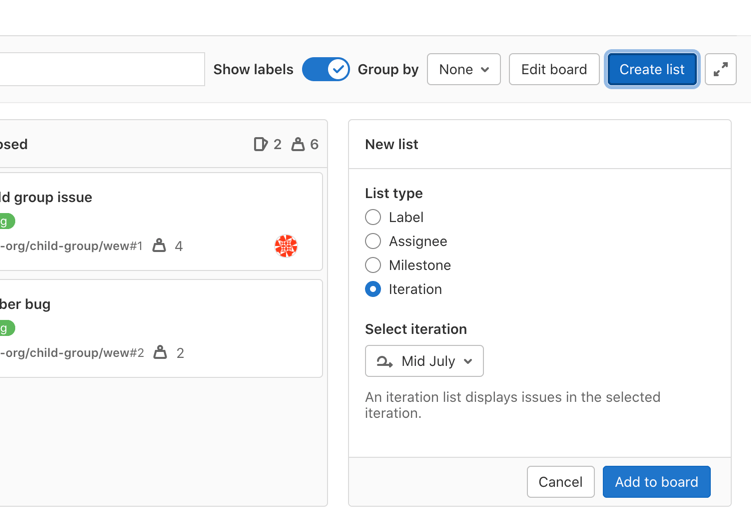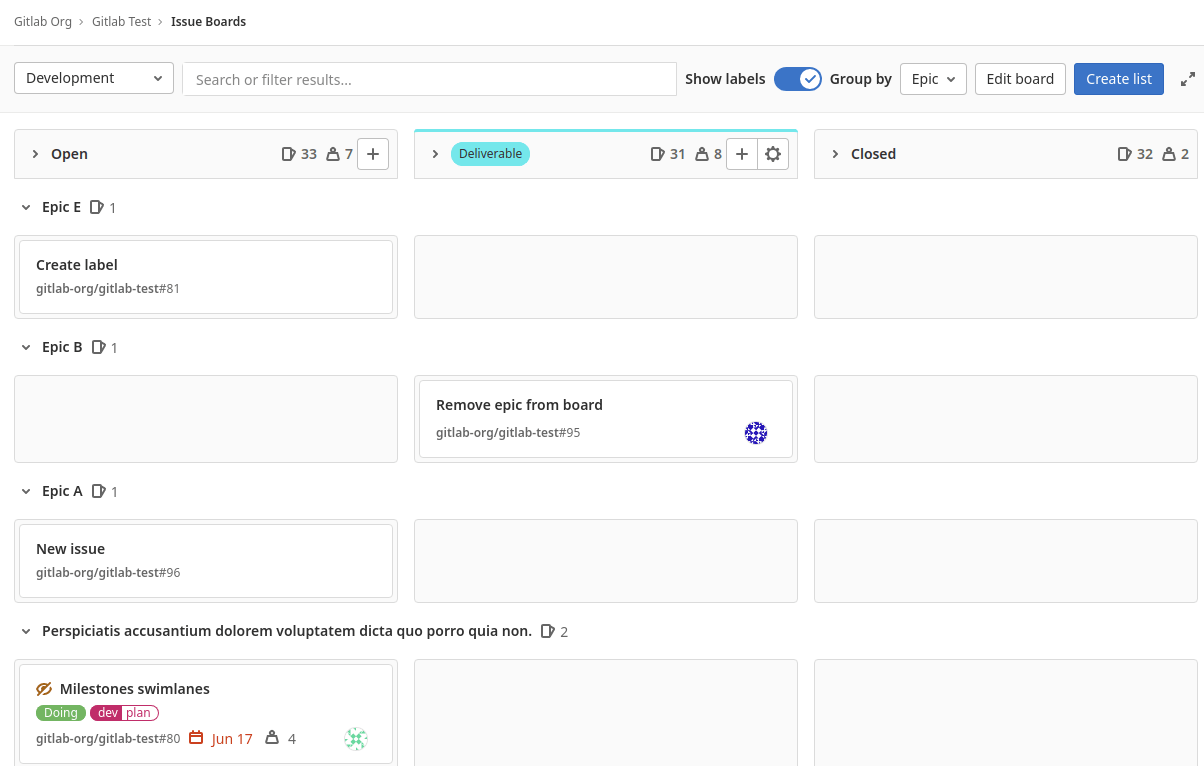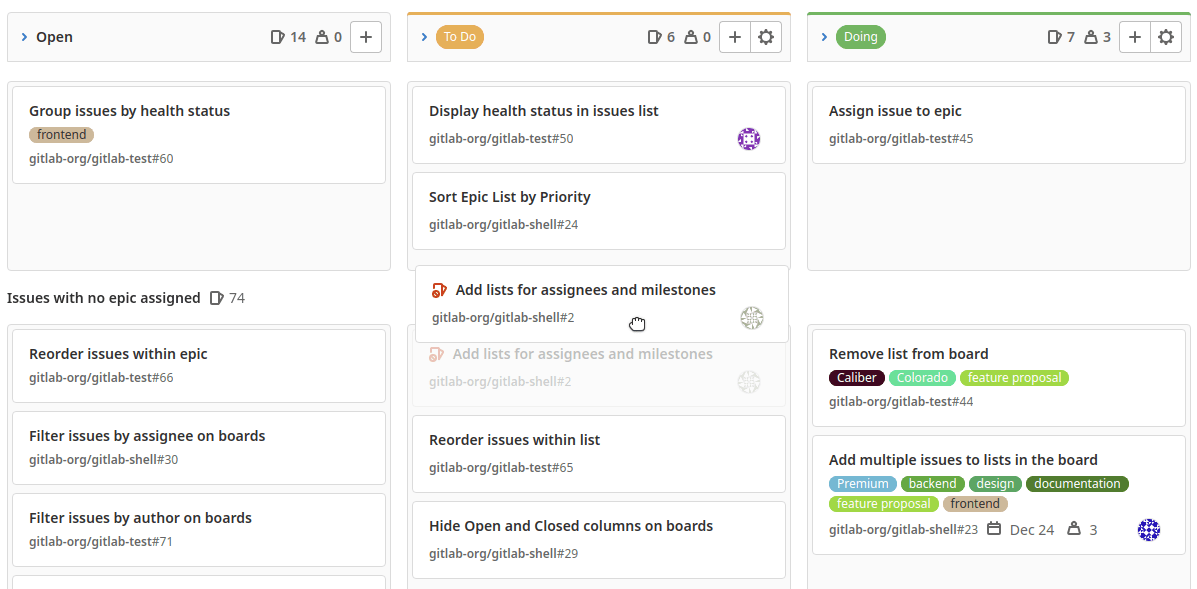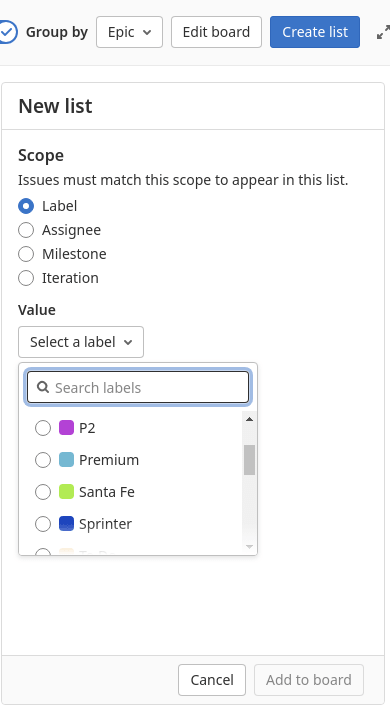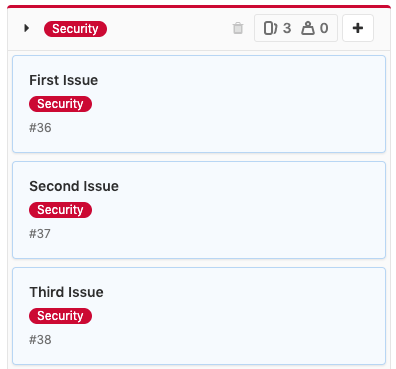Issue boards (FREE)
The issue board is a software project management tool used to plan, organize, and visualize a workflow for a feature or product release. It can be used as a Kanban or a Scrum board.
It pairs issue tracking and project management, keeping everything together, so that you don't need to jump between different platforms to organize your workflow.
Issue boards build on the existing issue tracking functionality and labels. Your issues appear as cards in vertical lists, organized by their assigned labels, milestones, or assignees.
Issue boards help you to visualize and manage your entire process in GitLab. You add your labels, and then create the corresponding list for your existing issues. When you're ready, you can drag your issue cards from one step to another one.
An issue board can show you the issues your team is working on, who is assigned to each, and where the issues are in the workflow.
To let your team members organize their own workflows, use multiple issue boards. This allows creating multiple issue boards in the same project.
Different issue board features are available in different GitLab tiers, as shown in the following table:
| Tier | Number of project issue boards | Number of group issue boards | Configurable issue boards | Assignee lists |
|---|---|---|---|---|
| Free | Multiple | 1 | No | No |
| Premium | Multiple | Multiple | Yes | Yes |
| Ultimate | Multiple | Multiple | Yes | Yes |
To learn more, visit GitLab Enterprise features for issue boards below.
Watch a video presentation of the issue board feature.
Multiple issue boards
- Multiple issue boards per project moved to GitLab Free in 12.1.
- Multiple issue boards per group are available in GitLab Premium.
Multiple issue boards allow for more than one issue board for a given project (FREE) or group (PREMIUM). This is great for large projects with more than one team or when a repository hosts the code of multiple products.
Using the search box at the top of the menu, you can filter the listed boards.
When you have ten or more boards available, a Recent section is also shown in the menu, with shortcuts to your last four visited boards.
When you're revisiting an issue board in a project or group with multiple boards, GitLab automatically loads the last board you visited.
Create an issue board
To create a new issue board:
- Click the dropdown with the current board name in the upper left corner of the issue boards page.
- Click Create new board.
- Enter the new board's name and select its scope: milestone, labels, assignee, or weight.
Delete an issue board
To delete the currently active issue board:
- Click the dropdown with the current board name in the upper left corner of the issue boards page.
- Click Delete board.
- Click Delete to confirm.
Issue boards use cases
You can tailor GitLab issue boards to your own preferred workflow. Here are some common use cases for issue boards.
For examples of using issue boards along with epics, issue health status, and scoped labels for various Agile frameworks, check:
- The How to use GitLab for Agile portfolio planning and project management blog post (November 2020)
- Cross-project Agile work management with GitLab (15 min, July 2020)
Use cases for a single issue board
With the GitLab Flow you can discuss proposals in issues, label them, and organize and prioritize them with issue boards.
For example, let's consider this simplified development workflow:
- You have a repository that hosts your application's codebase, and your team actively contributes code.
- Your backend team starts working on a new implementation, gathers feedback and approval, and passes it over to the frontend team.
- When frontend is complete, the new feature is deployed to a staging environment to be tested.
- When successful, it's deployed to production.
If you have the labels Backend, Frontend, Staging, and Production, and an issue board with a list for each, you can:
- Visualize the entire flow of implementations since the beginning of the development life cycle until deployed to production.
- Prioritize the issues in a list by moving them vertically.
- Move issues between lists to organize them according to the labels you've set.
- Add multiple issues to lists in the board by selecting one or more existing issues.
Use cases for multiple issue boards
With multiple issue boards, each team can have their own board to organize their workflow individually.
Scrum team
With multiple issue boards, each team has one board. Now you can move issues through each part of the process. For instance: To Do, Doing, and Done.
Organization of topics
Create lists to order issues by topic and quickly change them between topics or groups, such as between UX, Frontend, and Backend. The changes are reflected across boards, as changing lists updates the labels on each issue accordingly.
Advanced team handover
For example, suppose we have a UX team with an issue board that contains:
- To Do
- Doing
- Frontend
When finished with something, they move the card to Frontend. The Frontend team's board looks like:
- Frontend
- Doing
- Done
Cards finished by the UX team automatically appear in the Frontend column when they are ready for them.
NOTE: For a broader use case, please see the blog post What is GitLab Flow?. For a real use case example, you can read why Codepen decided to adopt issue boards to improve their workflow with multiple boards.
Quick assignments
To quickly assign issues to your team members:
- Create assignee lists for each team member.
- Drag an issue onto the team member's list.
Issue board terminology
An issue board represents a unique view of your issues. It can have multiple lists with each list consisting of issues represented by cards.
A list is a column on the issue board that displays issues matching certain attributes. In addition to the default "Open" and "Closed" lists, each additional list shows issues matching your chosen label, assignee, or milestone. On the top of each list you can see the number of issues that belong to it. Types of lists include:
- Open (default): all open issues that do not belong to one of the other lists. Always appears as the leftmost list.
- Closed (default): all closed issues. Always appears as the rightmost list.
- Label list: all open issues for a label.
- Assignee list: all open issues assigned to a user.
- Milestone list: all open issues for a milestone.
A Card is a box on a list, and it represents an issue. You can drag cards from one list to another to change their label, assignee, or milestone. The information you can see on a card includes:
- Issue title
- Associated labels
- Issue number
- Assignee
Permissions
Users with at least the Reporter role can use all the functionality of the issue board feature to create or delete lists. They can also drag issues from one list to another.
Ordering issues in a list
When an issue is created, the system assigns a relative order value that is greater than the maximum value of that issue's project or root group. This means the issue will be at the bottom of any issue list that it appears in.
When you visit a board, issues appear ordered in any list. You're able to change that order by dragging the issues. The changed order is saved, so that anybody who visits the same board later sees the reordering, with some exceptions.
Any time you drag and reorder the issue, its relative order value changes accordingly.
Then, any time that issue appears in any board, the ordering is done according to
the updated relative order value. If a user in your GitLab instance
drags issue A above issue B, the ordering is maintained when these two issues are subsequently
loaded in any board in the same instance.
This could be a different project board or a different group
board, for example.
This ordering also affects issue lists. Changing the order in an issue board changes the ordering in an issue list, and vice versa.
GitLab Enterprise features for issue boards
GitLab issue boards are available on the GitLab Free tier, but some advanced functionality is present in higher tiers only.
Configurable issue boards (PREMIUM)
- Setting current iteration as scope introduced in GitLab 13.8.
- Moved to GitLab Premium in 13.9.
An issue board can be associated with a milestone, labels, assignee, weight, and current iteration, which automatically filter the board issues accordingly. This allows you to create unique boards according to your team's need.
You can define the scope of your board when creating it or by clicking the Edit board button. After a milestone, iteration, assignee, or weight is assigned to an issue board, you can no longer filter through these in the search bar. In order to do that, you need to remove the desired scope (for example, milestone, assignee, or weight) from the issue board.
If you don't have editing permission in a board, you're still able to see the configuration by clicking View scope.
Watch a video presentation of the configurable issue board feature.
Focus mode
To enable or disable focus mode, select the Toggle focus mode button ({maximize}) at the top right. In focus mode, the navigation UI is hidden, allowing you to focus on issues in the board.
Sum of issue weights (PREMIUM)
Moved to GitLab Premium in 13.9.
The top of each list indicates the sum of issue weights for the issues that belong to that list. This is useful when using boards for capacity allocation, especially in combination with assignee lists.
Group issue boards
Accessible at the group navigation level, a group issue board offers the same features as a project-level board. It can display issues from all projects that fall under the group and its descendant subgroups.
Users on GitLab Free can use a single group issue board.
Assignee lists (PREMIUM)
Introduced in GitLab Premium 11.0.
As in a regular list showing all issues with a chosen label, you can add an assignee list that shows all issues assigned to a user. You can have a board with both label lists and assignee lists. To add an assignee list:
- Select Create list.
- Select Assignee.
- In the dropdown, select a user.
- Select Add to board.
Now that the assignee list is added, you can assign or unassign issues to that user by moving issues to and from an assignee list. To remove an assignee list, just as with a label list, click the trash icon.
Milestone lists (PREMIUM)
Introduced in GitLab Premium 11.2.
You're also able to create lists of a milestone. These are lists that filter issues by the assigned milestone, giving you more freedom and visibility on the issue board. To add a milestone list:
- Select Create list.
- Select Milestone.
- In the dropdown, select a milestone.
- Select Add to board.
Like the assignee lists, you're able to drag issues to and from a milestone list to manipulate the milestone of the dragged issues. As in other list types, click the trash icon to remove a list.
Iteration lists (PREMIUM)
- Introduced in GitLab 13.11 with a flag named
iteration_board_lists. Enabled by default.- Generally available in GitLab 14.6. Feature flag
iteration_board_listsremoved.
You're also able to create lists of an iteration. These lists filter issues by the assigned iteration.
To add an iteration list:
- Select Create list.
- Select Iteration.
- In the dropdown, select an iteration.
- Select Add to board.
Like the milestone lists, you're able to drag issues to and from a iteration list to manipulate the iteration of the dragged issues.
Group issues in swimlanes (PREMIUM)
- Grouping by epic introduced in GitLab Premium 13.6.
- Editing issue titles in the issue sidebar introduced in GitLab 13.8.
- Editing iteration in the issue sidebar introduced in GitLab 13.9.
With swimlanes you can visualize issues grouped by epic. Your issue board keeps all the other features, but with a different visual organization of issues. This feature is available both at the project and group level.
For a video overview, see Epics Swimlanes Walkthrough - 13.6 (November 2020).
To group issues by epic in an issue board:
- Select the Group by dropdown button.
- Select Epic.
To edit an issue without leaving this view, select the issue card (not its title), and a sidebar appears on the right. There you can see and edit the issue's:
- Title
- Assignees
- Epic (PREMIUM)
- Milestone
- Time tracking value (view only)
- Due date
- Labels
- Weight
- Notifications setting
You can also drag issues to change their position and epic assignment:
- To reorder an issue, drag it to the new position within a list.
- To assign an issue to another epic, drag it to the epic's horizontal lane.
- To unassign an issue from an epic, drag it to the Issues with no epic assigned lane.
- To move an issue to another epic and another list, at the same time, drag the issue diagonally.
Work In Progress limits (PREMIUM)
- Introduced in GitLab 12.7
- Moved to GitLab Premium in 13.9.
You can set a Work In Progress (WIP) limit for each issue list on an issue board. When a limit is set, the list's header shows the number of issues in the list and the soft limit of issues. You cannot set a WIP limit on the default lists (Open and Closed).
Examples:
- When you have a list with four issues and a limit of five, the header shows 4/5. If you exceed the limit, the current number of issues is shown in red.
- You have a list with five issues with a limit of five. When you move another issue to that list, the list's header displays 6/5, with the six shown in red.
To set a WIP limit for a list:
- Navigate to a Project or Group board of which you're a member.
- Click the settings icon in a list's header.
- Next to Work In Progress Limit, click Edit.
- Enter the maximum number of issues.
- Press Enter to save.
Blocked issues (PREMIUM)
- Introduced in GitLab 12.8.
- View blocking issues when hovering over blocked icon in GitLab 13.10.
If an issue is blocked by another issue, an icon appears next to its title to indicate its blocked status.
When you hover over the blocked icon ({issue-block}), a detailed information popover is displayed.
Actions you can take on an issue board
- Edit an issue.
- Create a new list.
- Remove an existing list.
- Remove an issue from a list.
- Filter issues that appear across your issue board.
- Create workflows.
- Move issues and lists.
- Multi-select issue cards.
- Drag and reorder the lists.
- Change issue labels (by dragging an issue between lists).
- Close an issue (by dragging it to the Closed list).
If you're not able to do some of the things above, make sure you have the right permissions.
Edit an issue
Editing title, iteration, and confidentiality introduced in GitLab 14.1.
You can edit an issue without leaving the board view. To open the right sidebar, select an issue card (not its title).
You can edit the following issue attributes in the right sidebar:
- Assignees
- Confidentiality
- Due date
- Epic
- Iteration
- Labels
- Milestone
- Notifications setting
- Title
- Weight
Additionally, you can also see the time tracking value.
Create a new list
Create a new list by clicking the Create button in the upper right corner of the issue board.
Then, choose the label, user or milestone to base the new list on. The new list is inserted at the end of the lists, before Closed. To move and reorder lists, drag them around.
Remove a list
Removing a list doesn't have any effect on issues and labels, as it's just the list view that's removed. You can always create it again later if you need.
To remove a list from an issue board:
- On the top of the list you want to remove, select the List settings icon ({settings}). The list settings sidebar opens on the right.
- Select Remove list. A confirmation dialog appears.
- Select OK.
Add issues to a list
The Add issues button was removed in GitLab 13.11.
If your board is scoped to one or more attributes, go to the issues you want to add and apply the same attributes as your board scope.
For example, to add an issue to a list scoped to the Doing label, in a group issue board:
- Go to an issue in the group or one of the subgroups or projects.
- Add the
Doinglabel.
The issue should now show in the Doing list on your issue board.
Remove an issue from a list
The Remove from board button was removed in GitLab 13.10.
When an issue should no longer belong to a list, you can remove it. The steps depend on the scope of the list:
- To open the right sidebar, select the issue card.
- Remove what's keeping the issue in the list. If it's a label list, remove the label. If it's an assignee list, unassign the user.
Filter issues
- Filtering by iteration introduced in GitLab 13.6.
- Filtering by issue type introduced in GitLab 14.6.
You can use the filters on top of your issue board to show only the results you want. It's similar to the filtering used in the issue tracker.
You can filter by the following:
- Assignee
- Author
- Epic
- Iteration
- Label
- Milestone
- My Reaction
- Release
- Type (issue/incident)
- Weight
Filtering issues in a group board
When filtering issues in a group board, keep this behavior in mind:
- Milestones: you can filter by the milestones belonging to the group and its descendant groups.
- Labels: you can only filter by the labels belonging to the group but not its descendant groups.
When you edit issues individually using the right sidebar, you can additionally select the milestones and labels from the project that the issue is from.
Create workflows
By reordering your lists, you can create workflows. As lists in issue boards are based on labels, it works out of the box with your existing issues.
So if you've already labeled things with Backend and Frontend, the issue appears in the lists as you create them. In addition, this means you can move something between lists by changing a label.
A typical workflow of using an issue board would be:
- You have created and prioritized labels to categorize your issues.
- You have a bunch of issues (ideally labeled).
- You visit the issue board and start creating lists to create a workflow.
- You move issues around in lists so that your team knows who should be working on what issue.
- When the work by one team is done, the issue can be dragged to the next list so someone else can pick it up.
- When the issue is finally resolved, the issue is moved to the Done list and gets automatically closed.
For example, you can create a list based on the label of Frontend and one for Backend. A designer can start working on an issue by adding it to the Frontend list. That way, everyone knows that this issue is now being worked on by the designers.
Then, when they're done, all they have to do is drag it to the next list, Backend. Then, a backend developer can eventually pick it up. When they're done, they move it to Done, to close the issue.
This process can be seen clearly when visiting an issue. With every move to another list, the label changes and a system note is recorded.
Move issues and lists
You can move issues and lists by dragging them.
Prerequisites:
- You must have at least the Reporter role for a project in GitLab.
To move an issue, select the issue card and drag it to another position in its current list or into a different list. Learn about possible effects in Dragging issues between lists.
To move a list, select its top bar, and drag it horizontally. You can't move the Open and Closed lists, but you can hide them when editing an issue board.
Dragging issues between lists
To move an issue to another list, select the issue card and drag it onto that list.
When you drag issues between lists, the result is different depending on the source list and the target list.
| To Open | To Closed | To label B list | To assignee Bob list | |
|---|---|---|---|---|
| From Open | - | Close issue | Add label B | Assign Bob |
| From Closed | Reopen issue | - | Reopen issue and add label B | Reopen issue and assign Bob |
| From label A list | Remove label A | Close issue | Remove label A and add label B | Assign Bob |
| From assignee Alice list | Unassign Alice | Close issue | Add label B | Unassign Alice and assign Bob |
Multi-select issue cards
- Introduced in GitLab 12.4.
- Placed behind a feature flag, disabled by default in GitLab 14.0.
FLAG:
On self-managed GitLab, by default this feature is not available. To make it available, ask an
administrator to enable the feature flag named board_multi_select.
On GitLab.com, this feature is not available.
The feature is not ready for production use.
You can select multiple issue cards, then drag the group to another position within the list, or to another list. This makes it faster to reorder many issues at once.
To select and move multiple cards:
- Select each card with Control+
Clickon Windows or Linux, or Command+Clickon MacOS. - Drag one of the selected cards to another position or list and all selected cards are moved.
First time using an issue board
- The automatic creation of the To Do and Doing lists introduced in GitLab 13.5.
- Deprecated in GitLab 13.7. In GitLab 13.7 and later, the To Do and Doing columns are not automatically created.
WARNING: This feature was deprecated in GitLab 13.7. The To Do and Doing columns are no longer automatically created.
In GitLab 13.5 and 13.6, the first time you open an issue board, you are presented with the default lists (Open, To Do, Doing, and Closed).
If the To Do and Doing labels don't exist in the project or group, they are created, and their lists appear as empty. If any of them already exists, the list is filled with the issues that have that label.
Tips
A few things to remember:
- Moving an issue between lists removes the label from the list it came from and adds the label from the list it goes to.
- An issue can exist in multiple lists if it has more than one label.
- Lists are populated with issues automatically if the issues are labeled.
- Clicking the issue title inside a card takes you to that issue.
- Clicking a label inside a card quickly filters the entire issue board and show only the issues from all lists that have that label.
- For performance and visibility reasons, each list shows the first 20 issues by default. If you have more than 20 issues, start scrolling down and the next 20 appear.
